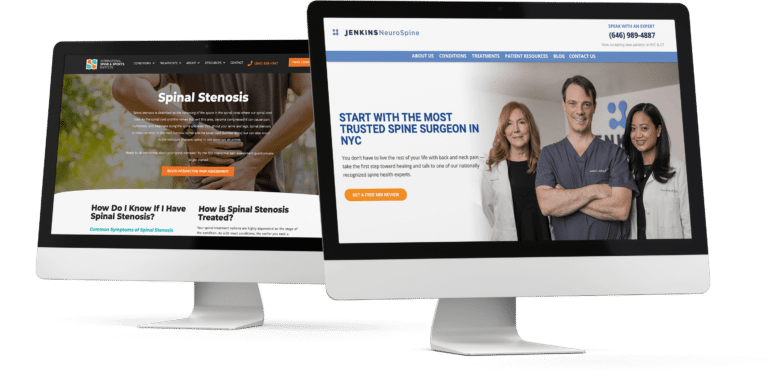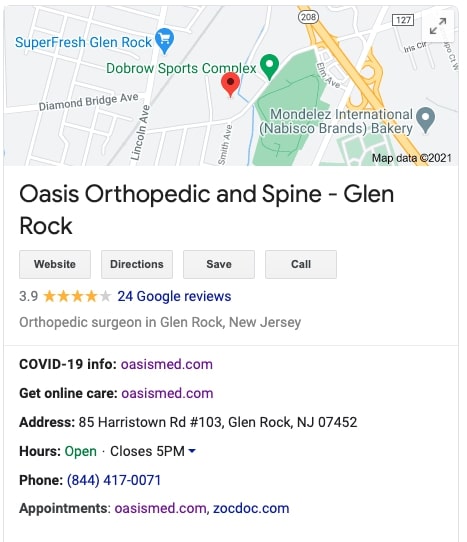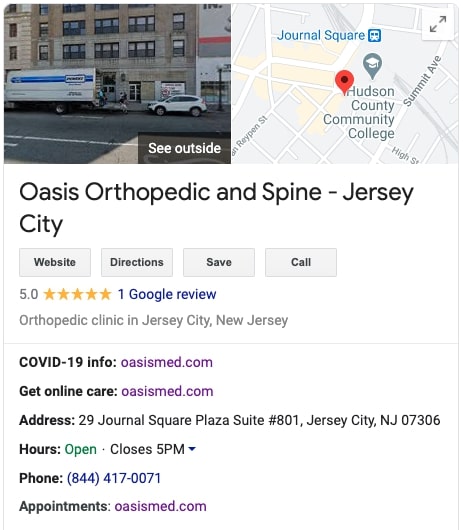
Marketing a medical group practice is different than marketing a single location. Each location has its challenges – separate competition, patient demographics, etc.
The medical group practices that succeed at marketing define a strategy that builds on the advantages of having multiple locations and providers. Done right, you can maximize your visibility in both paid and unpaid (organic) marketing.
How to Market to a Medical Practice Group in 2023 – 16 Strategies
In this post, I’ll take you through what we see as the essential strategies needed to grow a multi-location medical group practice.
- Consider Your Group Practice Name Carefully
- Make Sure Your Brand is Consistent
- Determine if You Will Combine Websites or Keep Separate
- Create Dedicated Pages for Each Location
- Make Sure All Locations Are Clear to Visitors
- Create Local Listings for Each Practice Location
- Create Local Listings for Each Doctor
- Implement a System for Collecting Group Practice Reviews
- Setup Your Social Profiles Correctly for Multiple Locations
- Publish Unique Posts and Content Relevant to Each Location
- Localize Your Keyword Research
- Establish a Per-Location Advertising Budget
- Define Clear Geographic Boundaries for Paid Advertising
- Track Leads Separately for Each Location
- Centralize Your Call Center
- Automate Communications, Segmented by Location
1. Consider Your Group Practice Name Carefully
Your medical group practice must have a name that’s not just descriptive but distinctive. It helps make your brand more memorable and easily found through Google Search.
Here’s an example of what NOT to do. Group practices that only use descriptive naming are in for trouble. For example, you would not want to name your practice “Texas Doctors Group” – there’s little chance you’ll show up #1 for that organic search. In addition, any paid Google Search advertising you do will also likely include patients searching for other physicians, and your cost-per-click will be higher.
Instead, it’s easier to build your brand with a more distinctive name – and it doesn’t have to be your physician’s last name.
2. Make Sure Your Brand is Consistent
One of the most essential best practices is ensuring that practices at each location operate under the same brand. While providers and locations may be different, you must begin to build a cohesive brand, especially if you plan to add more providers and locations down the road. This is critical for brands that allow individual locations to do their marketing – like events, sponsorships, etc.
You want a single logo and a well-defined visual identity that includes colors, fonts, and even photography. This often means creating a brand “style guide” to define and share these guidelines across locations.
More like this: An Introduction to The StoryBrand Framework and Actionable Branding: StoryBrand [Video]

3. Determine if You Will Combine Websites or Keep Separate
We generally recommend a single website rather than separate websites as a best practice. It’s less confusing for potential patients, and it’s certainly easier to have a single website to update when changes are needed.
Yet, having separate websites may not be avoidable – perhaps a unique partnership agreement with a physician where they retain ownership of their website. If it’s unavoidable, the same best practices apply; you’ll need to realize your efforts are compounded by having multiple sites.
We’ve created separate websites with a similar look and feel for some group practices, such as franchisee practices or MSOs wrapping up multiple independent practices. This allows the parent brand name & guidelines to be represented across all locations but with the different domain names that each practice location desires.
More like this:
- Medical Practice Website Design: 5 Must-Have Features for 2022
- Building A High-Performing Medical Practice Website in 2022
4. Create Dedicated Pages for Each Location
Each location in your group practice should have, at a minimum, a location page that details:
- The office location with a map
- Hours
- Contact information
- Providers
- Services
- Any other information that a patient may need
In addition to a location page for each unique location, we recommend creating localized treatment and condition pages for each location to optimize for local searches – “Podiatrist in Charlotte.” These are valuable in developing organic search traffic but critical to your paid media efforts.
A landing page from paid media that isn’t localized won’t convert as well. You want potential patients to understand that you have a location near them. We’ve seen cases where group practices don’t make the location clear, and patients can get confused about where the practice is.
More like this: SEO for Medical Practices: 12 Strategies for 2022
5. Make Sure All Locations Are Clear to Visitors
It must be crystal clear to any site visitors where you have locations. Many practice groups will put this information in the footer of the site. That’s an excellent place for it, but make sure you also have a “locations” navigation item at the top of your page. We recommend adding a module to your site that calls out locations on key pages without hoping visitors scroll down to your footer.
Remember, for many medical specialties; you’re competing against other local locations and national competitors that may offer telehealth services. Showcasing all locations can also help establish authority with potential patients by demonstrating your size.


6. Create Local Listings for Each Practice Location
The most important local marketing strategy you can implement for your practice is to have well-optimized Google Business Profile Listings for each practice location. This means having ALL information available filled out and taking advantage of advanced Google Business Profile listing features. Such as Messaging – which allows your practice to message potential patients directly from the listing.
You also want to distribute listings for each location beyond Google Business Profiles into other directories like Yelp, Apple Maps, and Bing. You will also need to manually submit practice listings to Healthcare directories that allow practice listings, like Healthgrades, ZocDoc, and WebMD.
7. Create Local Listings for Each Doctor
Most group practices, and medical practices in general, are not taking advantage of this particular strategy.
Not only does Google Business Profile allow you to create a listing for each location, but if you have multiple providers, you can create individual physician listings for each location.
Create listings for both providers and locations. It will help you gain MORE visibility and more opportunities to reach patients.

8. Implement a System for Collecting Group Practice Reviews
Reviews on your Google Business Profile listings are one of the most important signals for ranking.
The way to get a high volume of excellent reviews is to create a system that ensures you are consistently asking for reviews but that you’re doing it correctly.
We’ve found that the right way to ask for reviews is by asking the people most likely to give you a 5-star rating. So we’ve created a system that allows you to screen patients with a question before we ask them for a review on Google Business Profiles.
More like this: How To Grow Your Patient Reviews in 2022
9. Setup Your Social Profiles Correctly for Multiple Locations
One common mistake is practice groups creating separate Facebook pages rather than setting up a page for the practice brand and specifying multiple locations. This creates a “parent/child” relationship between pages and allows you to aggregate information and publish it in a single place, distributing it to all pages. This is also an important strategy that enables you to run Facebook advertising from a single account.
More like this: 4 of the Best Social Media Best Practices for Healthcare in 2022
10. Publish Unique Posts and Content Relevant to Each Location
While it may be tempting to create generic content such as blog posts or social posts for the entire practice, it’s important to publish more localized content to each location.
This is important because you want to build organic search traffic targeted to your service geographic area. In other words, getting site traffic from a blog post for “spine surgery” may attract people well outside your practice’s geographic footprint. But site traffic for “spine surgery in San Antonio” is much more likely to turn into a patient.
This local content can be published on the site and posted to your Google Business Profile listing for each location, and distributed via social media.
More like this: 4 Must-Haves in a Healthcare Content Marketing Strategy
11. Localize Your Keyword Research
Building great local content starts with keyword research.
When you’re researching the topics and keywords to align your content creation or optimize your website, don’t forget to include location modifiers.
For example – instead of just targeting “fertility doctors,” target “best fertility doctors in Philadelphia.” Prioritize your target keywords by which terms have the highest traffic and how competitive they are for ranking.
For this particular research, it’s wise to work with medical marketing experts who will understand how to identify the highest-intent keywords.
More like this:
- SEO for Medical Practices: 12 Strategies for 2022
- Fertility Clinic Marketing in 2022 – 9 Growth Strategies
12. Establish a Per-Location Advertising Budget
This is perhaps the biggest mistake in patient acquisition for multi-location medical practice groups. Too often see an advertising budget that’s the size of a single location getting split between multiple sites.
This usually does not meet the patient growth goals a practice group has in mind.
Instead, take the following two steps:
- Establish an overall paid advertising budget for the practice. How? Start with your revenue per patient – you should be willing to spend at least 5x the income of one patient per month. Here’s a helpful article I wrote on establishing a marketing budget.
- Divide that budget up between your locations, keeping in mind the different goals of each practice. Have a new practice launching? That one likely needs a more significant initial investment to raise awareness that it’s open. Does one practice need to drive significantly more new patients than the other? Make sure it has more budget.
More like this: How Much Should Your Practice Be Spending on Advertising in 2022?
13. Define Clear Geographic Boundaries for Paid Advertising
Defining clear boundaries between locations is essential when you begin paid marketing for your practice. This could be by defining a distance “radius” around each location (i.e., 10 miles). Or by defining specific zip codes, drawing some lines on a map, and working with your advertising partner to create those boundaries in your advertising platforms.
Make sure you don’t have overlapping audiences, so campaigns don’t compete with one another.
More like this: What’s A Good Conversion Rate for Medical Practices?
14. Track Leads Separately for Each Location
Now that you’ve got campaigns set up for each location, it’s essential to track your results based on location. Each paid campaign will likely perform differently. So you’ll need to understand how your marketing is performing and the KPIs you care about by location, including the number of leads, office visits, and procedures you’re generating for each.
More like this: Google Ads Benchmarks for Medical Practices (with Real Data!)
15. Centralize Your Call Center
One thing we’ve found very helpful is to centralize your call center. Of course, this doesn’t mean you can’t have phone numbers with area codes specific to your offices. Still, when someone dials that number, it directs them to a centralized call center that can then route calls to the correct office if needed.
This is important because we often see a lack of clear standards enforced when separate offices are handling leads. So we’ve invested in building our call center to offer clients. As a result, you can take all the proper steps in your marketing. Still, you’ve wasted those marketing dollars if a call isn’t answered or someone isn’t called back quickly after submitting a form.
More like this: How to Fix Your Medical Practice Call Center and Stop Losing Patients
16. Automate Communications, Segmented by Location
Our final recommendation is something we see practices with the highest patient conversion rates do. These practices automate their marketing efforts to augment their front desk’s great work.
What kind of automation? We recommend sending automated text messages.
For example, after someone submits a form to request an appointment or automated sequences of emails after form submission.
The goal will be to try and get in touch with someone who didn’t answer their phone on the first callback. We provide our clients with a marketing platform that enables this automation. We know what kinds of communication work best to convert leads into patients.
More like this: 3 Easy Ways to Automate Your Medical Practice Front Office
Putting it all together
The above strategies represent a best-in-class approach for medical practice groups with multiple locations and providers. However, we understand how difficult it can be for practices to implement these recommendations independently because each additional location adds new tasks and complexity that must be factored into the process.
That’s why you need to work with experts that understand how your practice works and how to tailor your marketing efforts to your practice needs. So request a consultation with a RUNNER marketing expert and create a marketing strategy for your practice group.
More like this: 43 Ways to Attract New Patients to Your Practice in 2023




